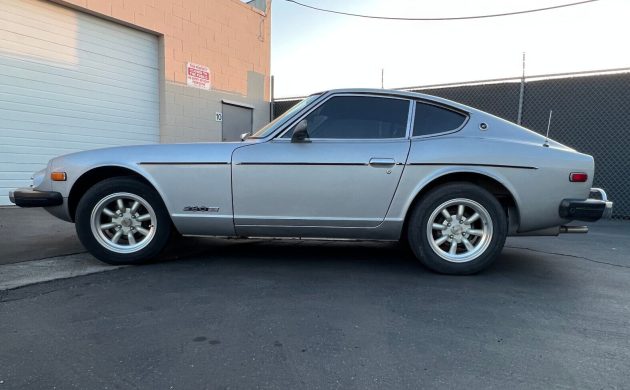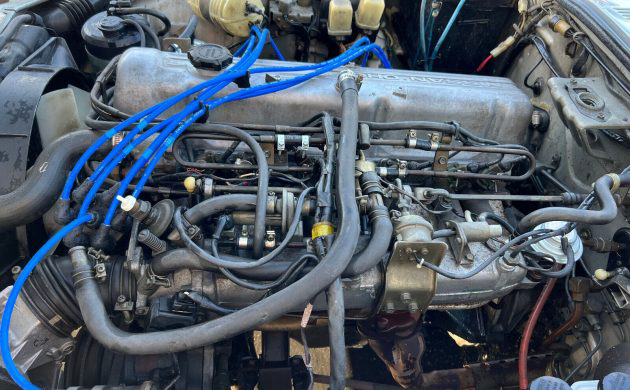
Datsun always claimed that it didn’t draw inspiration from the Jaguar E-Type when designing its iconic 240Z and its successors, but few believed that. From the long nose hiding a six-cylinder engine to the rear hatch, the similarities are too similar to be mere coincidence. The company performed ongoing upgrades to the range, culminating in the 280Z. Our feature car rolled off the line in 1976, recently returning to active service after years in storage. It is a turnkey proposition listed here on eBay in Phoenixville, Pennsylvania. If you’ve ever harbored doubts about the popularity of these classics, the thirty-six bids submitted prove people want to park this car in their garage. The action has pushed the price to $7,300, with the seller entertaining possible trades for the right vehicle.

This 280Z rolled off the line in 1976 and has spent years in dry storage. The seller describes it as an original survivor, and apart from the wheels, that seems an accurate assessment. The Metallic Silver paint retains a healthy shine, with the close-up shots revealing minor flaws and blemishes. These are especially apparent on the front valance, but a reputable paint shop should be able to touch-up that area to improve the appearance. However, if viewed purely as a survivor, the presentation is comfortably acceptable. The panels are straight, featuring tight and consistent gaps. Rust can be a significant headache with these cars, but this one seems to have avoided those problems. The seller supplies no images of the prone hatch opening, but the lower extremities and floors are rock-solid. The bumpers look slightly tired, although they may respond to work with a high-quality polish. The remaining trim is in good order, and there are no visible glass issues.

I braced myself when viewing the interior photos, expecting to find the typical cracks in the dash pad above the center gauge cluster. However, this 280Z sprung a pleasant surprise because the pad is flawless. I would probably add a cover to protect it from UV rays, but that is a good start since reproduction pads retail for over $800. The Black vinyl trim is in good order, and there is no appreciable carpet wear. Plastic trim is another weak point with these interiors, but there are no visible problems. Someone added an aftermarket radio/cassette player and door-mounted speakers, but those are the only visible changes to an interior that presents well.

I have always considered Datsun’s L-Series engine range one of the unsung heroes of the Japanese motor industry. They may not produce quite the power of the more sophisticated powerplants, but the engineering involved in their design makes them almost indestructible. Double valve springs and a dual-row timing chain allow them to rev safely beyond the recommended redline, and even when the chain has stretched and is rattling like a mad thing, failure is almost unheard of. The only genuine weaknesses are possible head gasket failure and brittle valve stem seals. The former is easy to rectify, and the latter typically only results in a minor increase in oil consumption and exhaust smoke when the driver hits the gas after rolling along on a trailing throttle. I have seen these engines clock over 300,000 miles with little work beyond regular servicing. The 2.8-liter L-Series in this car should send 170hp and 177 ft/lbs of torque to the road via a four-speed manual transmission. The ¼-mile ET of 16.6 seconds sounds modest, but outright performance wasn’t the aim of the exercise when Datsun designed these cars. They equipped them with excellent brakes and four-wheel independent suspension, making them rewarding when pointed at a twisting ribbon of tarmac. The seller recently coaxed this Datsun back to life, performing the required work to return it to a roadworthy state. It runs and drives perfectly and is a turnkey proposition for the winning bidder.

The 1976 Datsun 280Z has been one of the star performers in the classic market during the past year, with values climbing well above the market average. People love these cars because they are fun to drive. This one isn’t perfect, but reaching that point shouldn’t be difficult if the new owner isn’t concerned about sacrificing its survivor status. The bidding action proves the popularity of the 280Z, and with only a few days remaining on the auction, I expect it to become intense. Are you tempted to join that battle?




Got to be one of best examples I’ve seen in a while. Beautiful.
Absolutely, and the (imitation?) Minilites set it off nicely.
Is it me or does it look like it’s sitting a little bit lower than most of this vintage?
The street versions we have worked on have been that height. The 240s are just a bit lower.
These are hard to find in nice shape, mostly due to rust which was their weak point. You used to see 240/260/280Z’s all the time “back in the day”. The price on this car keeps going up as it gets more bids, and there’s more than two days left. If it tops $15k I wouldn’t be surprised..
I only need two words to describe this car:
WET DREAM
or
ABSOLUTELY FABULOUS
:)
Looks pretty nice for a large-bumper Z but those rub strips on the sides have to go – they are hideous.
I’ve never heard of an inline 6-cylinder high RPM tractor engine before. I suppose it’s possible, given the difference in the Japanese market, but that seems very unlikely.
Most tractors are high torque, low HP engines, the exact opposite of what you want in a sports car.
Unfortunately, you can’t take them off as it’s an aluminum track that’s rivetted to the body with a vinyl insert. Someone’s solution to them peeling off. And they always ran them down that detail line on the side which isn’t where car doors will hit it.
I heard that the engines in these things were derived from tractor engines and that’s why they would last a really long time. Can anyone verify that? I used to have a 280ZX and put 150k miles on it before I sold it.
You may be thinking of how the 240SX 4 cylinder was derived from truck engines.
Well, this dream is over. Lucky buyer!!
Well I had a 1978 Z in high school never had any issues,sure do miss that car, always wonder why it wasn’t a rag top